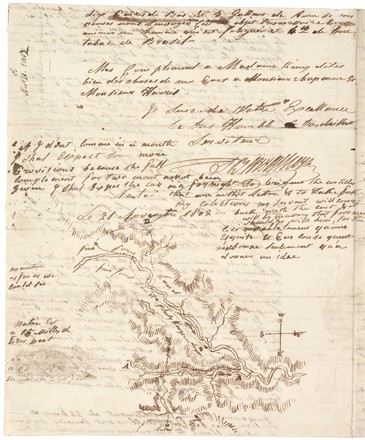Letter to Philip Gidley King
21 November 1802
A 1980 / 2 pp. 67-70
Manuscript letter
One of the first French settlers to arrive in the colony was engineer and explorer, Francis Louis Barrallier (1773–1853). In April 1800, Barrallier arrived in Sydney with the newly appointed governor of New South Wales, Philip Gidley King.
In October 1802, he set out on a short excursion inland to the west, and discovered the Nattai River where he set-up a supply depot for a future attempt to cross ‘the impassable’ Blue Mountains.
In this letter to Governor King, Barrallier reports on his journey; describing the country through which he travelled, and an encounter with a group of Aboriginal people.
The following month Barrallier made an attempt to cross The Blue Mountains, but was unsuccessful. Although his mission was considered a ‘failure’, and was a deterrent for many years to come, his effort to penetrate the mountain range is considered to be the most important initial attempt by a European.
A successful failure
Francis Louis Barrallier along
with four soldiers and five convicts attempted to cross The Blue Mountains.
Upon this expedition, the troop penetrated 161km into the region, and
discovered Byrnes' Gap as well as the Tonalli and Burragorang valleys. The
explorers were forced to abandon their mission at Kanangra Plateau due to
rugged terrain, wet weather and dwindling supplies, despite being one day away
from crossing the divide between Oberon and the Jenolan Caves.
The impassable divide
Francis Louis Barrallier
was not the first European to head into The Blue Mountains.
In 1796 George Bass (1771-1803)
(of Bass and Flinders fame) made the earliest recorded attempt to cross the
Great Divide. By tackling the steep cliffs with
scaling irons and ropes, the ill equipped group was forced to turn back after
14 days due to thirst, hunger and fatigue.
Despite many of the early
attempts by famous explorers to cross the Blue Mountains ended in failure, it
is believed that a little known ex-convict and bushman by the name of John
Wilson was the first white man to cross to the range between1792 and 1797.
Wilson probably used two or three of the main aboriginal paths which included a
route along the Cox River. His depictions of the crossing were accurate however
his achievements could never be verified.
An early inspiration
In November 1804, under the
employ of Sir Joseph Banks, botanist George Caley and his party followed in
Francis Louis Barrallier’s footsteps, and set off towards the Carmarthen Hills
(now known as the Blue Mountains) in a bid to cross the range. The exhausted
explorers managed to reach the awe-inspiring sheer cliffs that flank the Grose
River gorge, but failed to realise they were only one days march from the western
escarpment and open country beyond.



 Back to list
Back to list